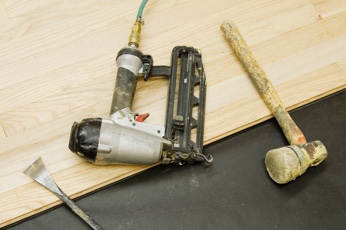
Floating installation
Floating installation is appropriate for engineered flooring. If you’re looking for a quick, nail-free floor installation, a floating floor is your best option. Unlike traditional solid hardwood installation, a floating floor isn’t nailed down to the subfloor. Instead, the planks are either glued or snapped together and sit atop the subfloor without being directly adhered to it.
Materials Needed
- Tite Bond II white waterproof glue or equal
- Weight(s)
- Measuring tape
- Saw
- Chisel
Resources
Things to keep in mind:
- Always review the instructions included in your box thoroughly before you start installation.
- Lay flooring only after sheetrock and tile work are thoroughly dried and all woodwork and trim have been completed.
- To prevent warping and gaps, the flooring needs to sit at least 48 hours in the space to acclimate to the temperature and humidity.
- No matter the material of the subfloor, test its moisture content with a moisture meter to confirm that it’s not above 12 percent.
- It’s best practice to install your hardwood floorboards parallel to the longest dimension in the room.
- Underlay for floating should be foam designed, with a maximum 1/8″ thickness.
- Tongue and groove should be glued together using Tite Bond II type white water proof glue or equal. Place glue in groove and tap boards together.
- Expansion space should be equal to the thickness of the material at all walls plus any vertical obstructions.
- Do not install cabinets or walls on top of a floating floor.



